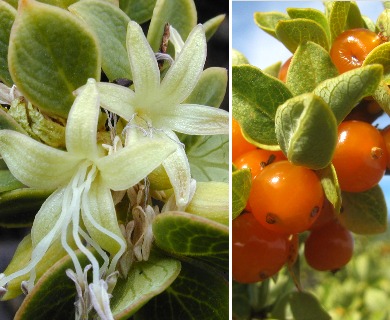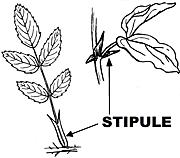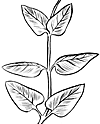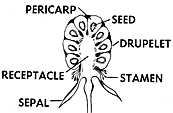Pilo
Coprosma montana
Madder family (Rubiaceae)
Native species ()
The Coprosma, common name pilo, has about 13 named species of shrubs and small trees through the Hawaiian Islands. These species have paired short-stalked small elliptical leaves with paired scalelike pointed hairy remaining on the slender twigs, small greenish or white flowers male and female on different plants, with tubular 4–9- one to many borne mostly at leaf bases, and small round yellow, orange, or black with two nutlets. One example follows.

©2003 Forest And Kim Starr
Leaves hairless, with short slender leaf-stalks less than 1⁄4 inch (6 ) long, and pointed hairy 1⁄8 inch (3 ) long, remaining at ringed Blades elliptical or lance-shaped, 3⁄8–1 inch (10–25 ) long and 1⁄4–1⁄2 inch (6–13 ) wide, slightly thickened or thin, blunt or short-pointed at both ends, dull green above, paler beneath.
Flowers male and female on different plants (), single, stalkless or nearly so on twigs behind leaves, about 1⁄4 inch (6 ) long. Female flowers have a cup-shaped base () with teeth, short tubular with 5–6 curved back, and with inferior two-celled and two Male flowers have as many as attached near base of tube and extending beyond.
() are rounded, 1⁄4 inch (6 ) in diameter, with teeth at shiny yellow to dark orange, turning black, containing two half-round nutlets. The has a disagreeable flavor.
Wood light brown, hard. In another species of the whitish yellow and soft.
The Coprosma is widespread in wet forests and mountain through the Hawaiian Islands. This species extends in mountains to high elevations, 6000–10,000 ft (1830–3048 ) on Mauna Kea, Hawaii. Other species reach tree size frequently in forests at 4000–8000 ft (1219–2438 ).
Special areas
Haleakala, Volcanoes, Kipuka Puaulu
Champion
Height 35 ft (10.7 ), c.b.h. 3.7 ft (1.1 ), spread 29 ft (8.8 ). Mauna Kea Forest Reserve, Humuula, Hawaii (1968).
Range
Restricted to Maui and Hawaii
Other common names
pilo kuahiwi (meaning mountain pilo), hupilo, mirrorplant








